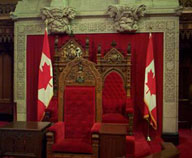C+ for Stephen Harper so far : the sleeping Frankenstein of Senate reform
Jun 25th, 2006 | By Counterweights Editors | Category: Ottawa Scene The CBC (Canadian Broadcasting Corporation) is slyly asking people to grade new minority Conservative Prime Minister Stephen Harper’s first five months in office, on what passes in English-speaking Canada for national TV.
The CBC (Canadian Broadcasting Corporation) is slyly asking people to grade new minority Conservative Prime Minister Stephen Harper’s first five months in office, on what passes in English-speaking Canada for national TV.
In our book Mr. Harper himself could be graded as high as C+. Whatever else, he has at least tried to gain ground on a few crucial Canadian nation-building issues, that have been languishing behind the scenes in Ottawa for a few too many years.
Being brave about “the Constitution” is back … sort of …
 Mr. Harper has also mostly indulged in a lot of smoke-and-mirrors political trivia, that he and a few other especially cynical observers of Canadian politics think just might win him a majority of seats in Parliament in the next federal election – as he so desperately desires.
Mr. Harper has also mostly indulged in a lot of smoke-and-mirrors political trivia, that he and a few other especially cynical observers of Canadian politics think just might win him a majority of seats in Parliament in the next federal election – as he so desperately desires.
And he is (make no mistake, Jack Layton and/or Gilles Duceppe) already trying hard enough to turn Canada into a more militarist and ideologically right-wing kind of place than it has been in the more recent past – or even perhaps since the Boer War of 1899-1902.
But it’s the start of summer 2006. The mood is supposed to be upbeat. Prime Minister Harper has in some degree redeemed himself over the past five months, with his more or less high-minded concern for two longstanding constitutional issues that are bound to have a big impact on whatever fate may have in store for the Canadian future.
The first is the deeply confusing, twisted, and only allegedly Western Canadian cause of Senate reform. And the second is some kind of formal recognition of French-speaking Quebec’s unique place in modern Canadian federalism.
 Even here, Mr. Harper deserves no better than a C+. It is still, e.g., not remotely clear just where he is going with these two issues. (Perhaps or probably even to him?) And a constitutional amendment on Senate reform just proposed by Senators Jack Austin and Lowell Murray suggests that the first issue could wind up going in some foolish directions.
Even here, Mr. Harper deserves no better than a C+. It is still, e.g., not remotely clear just where he is going with these two issues. (Perhaps or probably even to him?) And a constitutional amendment on Senate reform just proposed by Senators Jack Austin and Lowell Murray suggests that the first issue could wind up going in some foolish directions.
Mr. Harper deserves only a C+ for another reason too. That is his abject silence on a third longstanding Canadian constitutional issue – aboriginal rights (and land claims). And he has kept to his silence at a time when the issue itself has been starting to cause some authentic practical political trouble (at least if you live on the easterly edge of Southwestern Ontario).
We started out here thinking that we might just offer a few brief further notes on recent developments in each of these three traditional Canadian constitutional land-mine subjects – Senate reform, Quebec in the confederation, and aboriginal rights. But, the world being what it is nowadays Senate reform just overwhelmed us.
So we’ll get back to Quebec and aboriginal rights at some later point. For the moment, what follows is far more than anyone really wanted to know, or otherwise hear about, on the current state of the Senate reform debate in Canada – an important subject, in Canada, albeit one that does not usually excite the mass imagination (for many all-too-obvious reasons, of course).
The Austin-Murray Amendment … a new Frankenstein Senate in the wings?
 Astonishingly enough, the latest sort-of big news on Senate reform (wake me when it’s over?) comes from the Senate itself. Senator Jack Austin from British Columbia and Senator Lowell Murray, originally from Nova Scotia (but currently filling an Ontario seat), have tabled a resolution that would increase the number of seats for Western Canada in that not-so-august body.
Astonishingly enough, the latest sort-of big news on Senate reform (wake me when it’s over?) comes from the Senate itself. Senator Jack Austin from British Columbia and Senator Lowell Murray, originally from Nova Scotia (but currently filling an Ontario seat), have tabled a resolution that would increase the number of seats for Western Canada in that not-so-august body.
More exactly, they have proposed a constitutional amendment, which would increase BC’s Senate seats from 6 to 12, Alberta’s from 6 to 10, and each of Saskatchewan’s and Manitoba’s from 6 to 7.
To take ultimate effect, under the Constitution Act 1982, this kind of constitutional amendment would have to be approved by both the Senate and the Canadian House of Commons, and then the legislatures of seven provinces, that collectively account for at least 50% of the cross-Canada population.
(Or, put another way, at least one of Ontario and/or Quebec would have to be included among the seven approving provinces.)
1. Prime Minister Harper’s new pragmatic Senate reform campaign promise
 Before getting into its potential foolishness, it is worth stressing that this proposed “Austin-Murray Amendment” also has its own high-minded sides.
Before getting into its potential foolishness, it is worth stressing that this proposed “Austin-Murray Amendment” also has its own high-minded sides.
In some respects it is a constructive contribution to the pragmatic and practical political new debate on Senate reform, that Prime Minister Harper has at least set in motion over the past five months, as evidence of his own high-minded Canadian nation-building concerns.
Mr. Harper kicked things off in this past January’s federal election campaign by promising a new “step-by-step” approach to the languishing old constitutional issue of Senate reform.
Full-blown comprehensive reform in the interests of enhanced regional representation in Ottawa – the kind of thing that had figured prematurely in the failed Charlottetown Accord of 1992 – was still not practically possible for the moment. But the new Prime Minister Harper would at least take what steps he could, to start turning the present appointed Senate (i.e. appointed by the prime minister himself) into a properly democratic elected body.
2. The eight-year-term as a still more pragmatic baby step to grease the wheels
 As often happens with such promises, once Prime Minister Harper was so precariously installed in office, with his 125-out-of-308 seats minority government, it became clear that even his step-by-step elected Senate concept created some fresh practical problems, that no one in charge had altogether focused on when it was all just a bold new idea in an election platform.
As often happens with such promises, once Prime Minister Harper was so precariously installed in office, with his 125-out-of-308 seats minority government, it became clear that even his step-by-step elected Senate concept created some fresh practical problems, that no one in charge had altogether focused on when it was all just a bold new idea in an election platform.
In particular, an increasingly elected Senate with the present highly dysfunctional pattern of regional representation in provincial allocations of Senate seats could create a Frankenstein, especially for the Western Canada that Mr. Harper had at last brought to real power and influence in Ottawa.
So Prime Minister Harper adroitly scaled back his original step-by-step approach to Senate reform, to begin with what the media has aptly characterized as an extremely modest “baby step.” He has tabled legislation in Parliament that would just reduce the current up-to-75-years-old term of Canadian Senators to a mere eight years.
The theory here seems to be that something like this eventually needs to be done. It will at least light a small fire under the higher cause of electing Senators, and it is more practically doable right now.
(It doesn’t raise the troubling problem of Western Canadian “under-representation” for the moment. And the eight-year term reform, e.g., requires a constitutional amendment, but, according to Mr. Harper at any rate, one that only needs approval by the Parliament in Ottawa, and not any provincial legislatures.)
Moreover, the baby step is still just a beginning. The original commitment remains intact. As the media is still reporting, Mr. Harper is still promising some kind of still further movement ahead on “senate electoral reform by the next federal election.”
3. Along come Jack and Lowell … from the “Chamber of Sober Second Thought” itself …
 At first blush, the new scheme just advanced by Senators Jack Austin and Lowell Murray would seem to fit nicely enough into the prime minister’s emerging Senate reform plot. It actually addresses one of the fresh practical problems with step-by-step elected Senate reform, that no one in charge had altogether focused on when it was all just a bold new idea in an election platform.
At first blush, the new scheme just advanced by Senators Jack Austin and Lowell Murray would seem to fit nicely enough into the prime minister’s emerging Senate reform plot. It actually addresses one of the fresh practical problems with step-by-step elected Senate reform, that no one in charge had altogether focused on when it was all just a bold new idea in an election platform.
More exactly, the Austin-Murray Amendment, the Canadian Press reports, “would resolve one of the prime objections to electing senators” at the moment, given the dysfunctional pattern of regional representation in the Senate as it stands. I.e.: “Many critics have argued that the current under-representation of Western Canada would become a far more serious problem in an elected upper house, where democratically chosen senators would have more legitimacy and would thus be less reticent about wielding their considerable legislative powers.”
At first blush again, you might say all this shows that Prime Minister Harper really is quite a lot smarter than the average bear. He knows very well (as, e.g., Paul Martin quietly urged in this past January’s federal election campaign) that there is a problem with step-by-step Senate reform. There is so much wrong with the present unreformed Senate of Canada that if you take just one step, without taking various parallel other steps at the same time, you could easily create a new Frankenstein Senate in Ottawa.
But Prime Minister Harper also knows that the trick is just to get the reform process started as a matter of practical politics. Once one step – any step at all – gets moving, the other steps will gradually fall into place. If you start to build it, others will soon enough come to help finish the job – as the new Austin-Murray Amendment has already started to demonstrate.
4. But then the bad news begins …
 It is at this point, alas, that the good news starts to end. Just for openers, some will say that the kind of constitutional amendment with the approval of seven provinces and so forth, as required by the Austin-Murray Amendment, is still just so much pie in the sky, as any matter of practical politics in any foreseeable future.
It is at this point, alas, that the good news starts to end. Just for openers, some will say that the kind of constitutional amendment with the approval of seven provinces and so forth, as required by the Austin-Murray Amendment, is still just so much pie in the sky, as any matter of practical politics in any foreseeable future.
(And then there’s even an argument about whether Mr. Harper’s eight-year term baby-step reform itself may not in fact require the same kind of more demanding “7/50″amendment, with provincial approval, regardless of what Mr. Harper claims.)
However, this is all mere grist for clever repartee among constitutional fanatics, as they gather for drinks after work. The biggest and most serious trouble with the proposed Austin-Murray Amendment is that it does not go remotely far enough in reforming the present dysfunctional pattern of regional representation in the unreformed Senate of Canada.
If we the Canadian people are actually going to try to struggle through a full-blown “7/50” constitutional amendment on what provinces get exactly what numbers of seats in a meaningfully reformed elected Senate in Ottawa, the enterprise has to do much more than Senators Austin and Murray are currently envisioning, to make any kind of ultimate good sense.
5. What is the point of a Frankenstein Senate that doesn’t really represent regional interests in Ottawa, instead of in the offices of provincial premiers?
 Senators Austin and Murray are claiming that they too are just joining in on the new pragmatic reform mood. Their proposal, they argue, has at least some chance of winning the required level of provincial approval, because it does not take any seats away from provinces outside Western Canada. Their “initiative is achievable because other regions aren’t being asked to give up seats.”
Senators Austin and Murray are claiming that they too are just joining in on the new pragmatic reform mood. Their proposal, they argue, has at least some chance of winning the required level of provincial approval, because it does not take any seats away from provinces outside Western Canada. Their “initiative is achievable because other regions aren’t being asked to give up seats.”
But that is also one part of the problem. The Austin-Murray Amendment would actually increase the size of the present Senate from 105 to 117 members. And that is moving in the wrong direction just to start with. A sensible regionally representative and elected reformed Canadian Senate would look more like the regionally representative 76-member Senate in Australia.
The still more telling and fundamental problem is reflected in a quotation from the June 22 Canadian Press report on the issue: “The number of senators assigned is roughly in line with the population of B.C. and the Prairie provinces,’ Mr. Austin said in an explanatory letter to B.C. Premier Gordon Campbell’s deputy minister.”
At this point anyone who has been seriously following the issue over the past 25 years has to almost scream POPULATION? What has population got to do with the Senate? This only echoes Ontario Premier Dalton McGunity’s recent profound intellectual travesty on the Senate reform debate, when he complained that Ontario has almost 39% of the Canadian population, but only about 22% of the seats in the current unreformed Senate.
From any altogether sensible perspective, the relative populations of the different provinces are already nicely represented in the elected Canadian House of Commons. There is absolutely no need for two rival elected legislatures in Ottawa, each of which more or less represents the same thing. That would just be an institutional Frankenstein that serves no practical purpose.
 The whole point of Senate reform is to create a branch of the federal Parliament that more adequately represents regional interests inside federal institutions, as a kind of geographic counterweight to the more or less exact representation by population in the House of Commons. Especially since the two central provinces of Ontario and Quebec together still have a majority of the Canadian population, and thus a majority of seats in the Commons.
The whole point of Senate reform is to create a branch of the federal Parliament that more adequately represents regional interests inside federal institutions, as a kind of geographic counterweight to the more or less exact representation by population in the House of Commons. Especially since the two central provinces of Ontario and Quebec together still have a majority of the Canadian population, and thus a majority of seats in the Commons.
As matters stand, Canadian federal politics is haunted by a fractious regionalism that eats away at vigorous hopes for any stronger nation-building future. A big part of the problem is that there is still too little voice for regional interests, beyond the two most populous provinces of Ontario and Quebec, in federal institutions at Ottawa – even with an Alberta-based minority federal government like Mr. Harper’s in office at last.
The result is that provincial premiers wind up speaking for regional interests in national debates. That just creates confusion about who is running Canada (as opposed to the already considerable constitutionally mandated responsibilities of its constituent provinces)? The provincial premiers – at, e.g., their annual summer meetings, recently renamed the “Council of the Federation” – or the duly elected federal government in Ottawa?
The whole point of reforming the Senate – as opposed to just abolishing it, as various provincial premiers have suggested lately – is to strengthen Canada from coast to coast to coast, by creating an effective new voice for regional interests inside federal institutions. And the additional deck chairs for Western Canada in the proposed Austin-Murray Amendment just do not go at all far enough in reforming the current dysfunctional pattern of regional representation in the Senate to achieve anything like this. The Austin-Murray project is only easier to do (even if it really is, which also remains quite unclear), because it just gives up on doing the difficult thing that is really important.
6. But will it still spark a much-needed healthy debate on workable alternatives to equal provincial representation at last?
 The solution to all this that has long figured in the grandest designs of Western Canadian Senate reformers – or at least those from Alberta (who may even be in a minority in their own province, if the deepest truth were known?) – is a reformed Senate that has equal representation for each province.
The solution to all this that has long figured in the grandest designs of Western Canadian Senate reformers – or at least those from Alberta (who may even be in a minority in their own province, if the deepest truth were known?) – is a reformed Senate that has equal representation for each province.
This just follows the model that has long existed in the regionally representative Senates of both Australia and the United States – neither of which suffers from quite the same kind of intensely fractious regionalism that Canada suffers from. Alas, the ongoing debate since the early 1990s has at least made clear to those paying serious attention that equal representation for each province will not work in Canada, which is not a country quite like either Australia or the United States.
The first big problem, as usual, is French-speaking Quebec, which is bound to bridle at the concept of equal provincial representation, because ever since 1867 it has been, in its own mind at least, “not a province like the others.”
The second big problem is that, even if you set aside Quebec, Canada is more polarized between large-population and small-population provinces (or states) than either Australia or the United States. The Senate is not about population, but …
A provincially equal Senate would give the six least populous of the present 10 provinces a majority of Senate seats, even though they collectively have only about 14% of the total Canadian population. And an effective virtually co-equal legislature of this sort in the federal Parliament grates a little too much against the sensitivities of the cross-Canada democracy, where every adult citizen has one equal vote. (To say nothing about what it might do for the already rancorous arguments about how to calculate federal-provincial equalization payments.)
 Concerns of this sort were at least implicitly acknowledged in the Harper Conservatives’ campaign talk on Senate reform, which nicely fudged on the traditional question of equal provincial representation. Some Western Canadian Senate reformers even seem to have concluded that this must mean Senate reform cannot finally be just about regional representation. As Roger Gibbins of the Canada West Foundation has recently explained: ” Over time … I’ve found the regional representation argument less compelling than the need to have some sort of counterweight to the concentration of power [in the Prime Minister’s Office].”
Concerns of this sort were at least implicitly acknowledged in the Harper Conservatives’ campaign talk on Senate reform, which nicely fudged on the traditional question of equal provincial representation. Some Western Canadian Senate reformers even seem to have concluded that this must mean Senate reform cannot finally be just about regional representation. As Roger Gibbins of the Canada West Foundation has recently explained: ” Over time … I’ve found the regional representation argument less compelling than the need to have some sort of counterweight to the concentration of power [in the Prime Minister’s Office].”
Yet Senate reform nowadays finally does have to be about regional representation, or it doesn’t make any sense at all. There is no longer a need for a Canadian Senate that tries to serve as a check on too much democracy in Canada, in the manner of the 19th century British House of Lords. The Canadian House of Commons already represents the cross-Canada democracy by population. What else can a sensible reformed Senate of the 21st century represent than raw geography, so to speak, as a counterweight to raw numbers of people?
Or, as Roger Gibbins is also still urging, there remains a great Canadian need to give “provincial and regional interests a more secure voice in federal decision-making. We had this 30-year the-West-wants-in campaign … Well, the West is in, but we’re in because of a particular Prime Minister being in office. What we want to do is put into play a modest set of institutional reforms so that we don’t have to rely on the fickleness of the party system to provide regional representation.'”
Moreover, there is still plenty of room for avoiding the problems that strictly equal provincial representation, as in Australia and the United States, would create in Canada’s unique national circumstances, while still creating a much more regionally representative Senate than the one Canada has now. Or than the one that would result from the kind of mild tinkering to boost Western Canada’s current representation, envisioned in the new Austin-Murray Amendment.
 Just to be provocative for the moment, e.g., what about this kind of regionally representative allocation of seats in a reformed Senate: Quebec – 12 seats; Ontario, British Columbia, and Alberta – 6 seats each; Manitoba, Saskatchewan, Nova Scotia, New Brunswick, Newfoundland and Labrador, and Prince Edward Island – 3 seats each? And then, just to round things out, what about adding a few more seats for the northern territories, and what the Constitution Act 1982 calls “the aboriginal peoples of Canada”?
Just to be provocative for the moment, e.g., what about this kind of regionally representative allocation of seats in a reformed Senate: Quebec – 12 seats; Ontario, British Columbia, and Alberta – 6 seats each; Manitoba, Saskatchewan, Nova Scotia, New Brunswick, Newfoundland and Labrador, and Prince Edward Island – 3 seats each? And then, just to round things out, what about adding a few more seats for the northern territories, and what the Constitution Act 1982 calls “the aboriginal peoples of Canada”?
To finish on a note more in keeping with the mandated upbeat summer mood, in the best of all possible current Canadian worlds, further discussion on the new Austin-Murray Amendment at least ought to stimulate fresh and more constructive debate on just what kind of new scheme of regional representation in a reformed Senate really does make sense. The adding of a few extra deck chairs for Western Canada may seem more expedient. But it will still leave the worn-out current dysfunctional scheme of regional representation essentially intact. Why go to all the bother of a “7/50” constitutional amendment for that? There is no point in creating a new Frankenstein in Ottawa, if it isn’t really going to serve any useful purpose at all.
Meanwhile, it is probably still a good idea to raise a glass to Senator Jack Austin and Senator Lowell Murray this coming Canada Day 2006. Whatever else, they are trying to do something constructive about the Canadian future – even if it will never get them elected or re-elected to any public office. And, one way or another, the debate on their new Senate reform proposal could finally wind up as at least as another modest baby step, in some ultimate right direction.
APPENDIX: CURRENTÂ REGIONAL REPRESENTATION IN THE CANADIAN SENATE
 With a bow to the neighbouring Great Republic, the Canadian Senate created in 1867 was supposed to have at least some degree of regional representation. The Canada of the day was “deemed to consist of” three regional divisions, each of which would be “equally represented” by 24 Senators.
With a bow to the neighbouring Great Republic, the Canadian Senate created in 1867 was supposed to have at least some degree of regional representation. The Canada of the day was “deemed to consist of” three regional divisions, each of which would be “equally represented” by 24 Senators.
By the early 20th century the growth of the new west had added a fourth division, equally represented by 24 Senators. Then the final addition of Newfoundland in 1949 added an additional 6 Senators. And then the present three northern territories were allocated one Senator each. Which all adds up to the current appointed Senate of 105 members, allocated among Canada and its provinces as follows:
|
Region/Province |
% Canadian population 2006 |
Number of Senators |
|
Division 1. Ontario |
38.9 |
24 |
|
Division 2. Quebec |
23.5 |
24 |
|
Division 3. Maritime Provinces |
5.6 |
24 |
|
Nova Scotia |
(2.9) |
(10) |
|
New Brunswick |
(2.3) |
(10) |
|
Prince Edward Island |
(0.4) |
(4) |
|
Division 4. Western Provinces |
30.0 |
24 |
|
British Columbia |
(13.2) |
(6) |
|
Alberta |
(10.2) |
(6) |
|
Manitoba |
(3.6) |
(6) |
|
Saskatchewan |
(3.0) |
(6) |
|
Newfoundland and Labrador |
1.6 |
6 |
|
Northern Territories |
0.4 |
3 |
|
CANADA |
100.0 |
105 |
